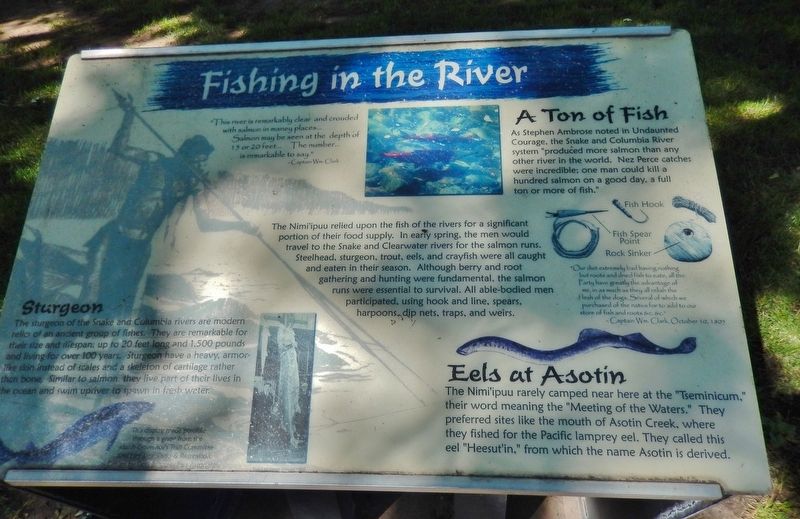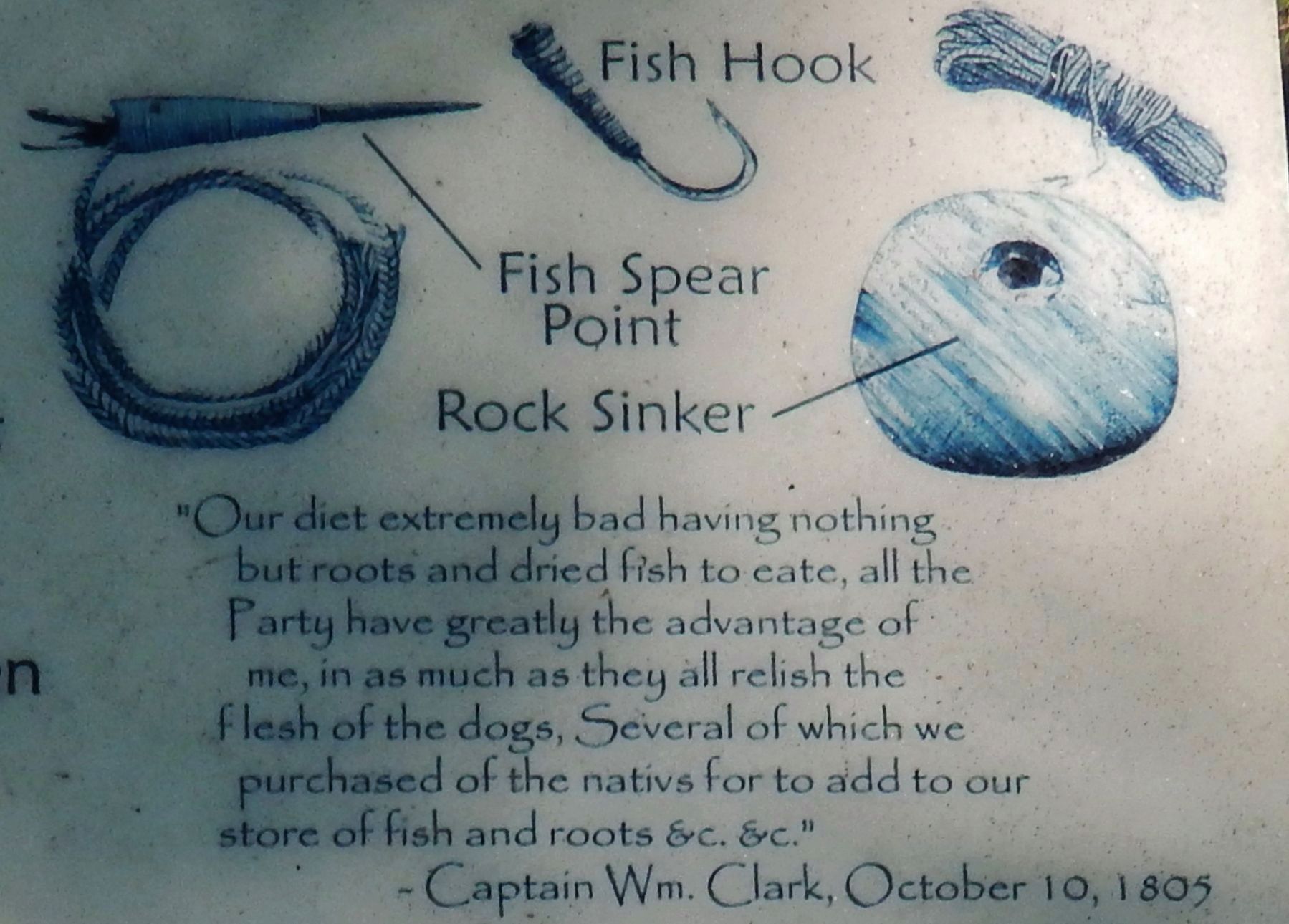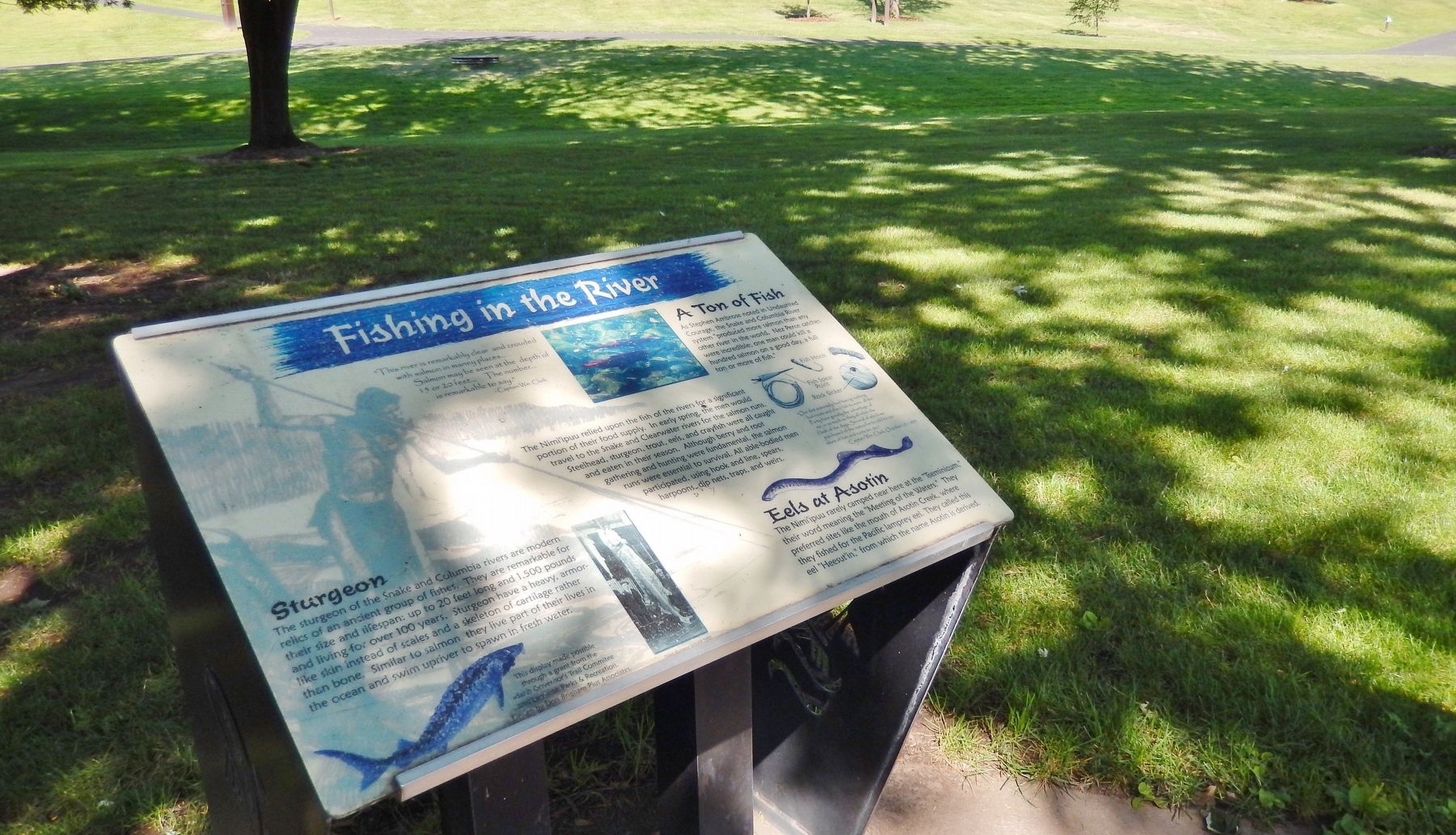Lewiston in Nez Perce County, Idaho — The American West (Mountains)
Fishing in the River
”This river is remarkably clear and crowded with salmon in maney places…
Salmon may be seen at the depth of 15 or 20 feet…
The number…
Is remarkable to say.”
~Captain Wm. Clark
The Nimi’ipuu relied upon the fish of the rivers for a significant portion of their food supply. In early spring, the men would travel to the Snake and Clearwater rivers for the salmon runs. Steelhead, sturgeon, trout, eels, and crayfish were all caught and eaten in their season. Although berry and root gathering and hunting were fundamental, the salmon runs were essential to survival. All able-bodied men participated, using hook and line, spears, harpoons, dip nets, traps, and weirs.
Sturgeon
The sturgeon of the Snake and Columbia rivers are modern relics of an ancient group of fishes. They are remarkable for their size and lifespan: up to 20 feet long and 1,500 pounds and living for over 100 years. Sturgeon have a heavy, armor-like skin instead of scales and a skeleton of cartilage rather than bone. Similar to salmon, they live part of their lives in the ocean and swim upriver to spawn in fresh water.
A Ton of Fish
As Stephen Ambrose noted in Undaunted Courage, the Snake and Columbia River system “produced more salmon than any other river in the world. Nez Perce catches were incredible: one man could kill a hundred salmon on a good day, a full ton or more of fish.”
”Our diet extremely bad having nothing but roots and dried fish to eate, all the Party have greatly the advantage of me, in as much as they all relish the flesh of the dogs, Several of which we purchased of the nativs for to add to our store of fish and roots &c. &c. “
~Captain Wm. Clark, October 10, 1805
Eels at Asotin
The Nimi’ipuu rarely camped near here at the “Tseminicum,” their word meaning the “Meeting of the Waters.” They preferred sites like the mouth of Asotin Creek, where they fished for the Pacific lamprey eel. They called this ell ”Heesut’in,” from which the name Asotin is derived.
Erected by Idaho Governor's Lewis & Clark Trail Committee, Lewiston Parks & Recreation.
Topics and series. This historical marker is listed in these topic lists: Exploration • Native Americans. In addition, it is included in the Lewis & Clark Expedition series list.
Location. 46° 24.72′ N, 117° 1.997′ W. Marker is in Lewiston, Idaho, in Nez Perce County. Marker is on Snake River Avenue, 0.3 miles south of U.S. 12, on the right when traveling south. Marker is located along the walking trail in Lewiston's Kiwanis Park. Touch for map. Marker is in this post office area: Lewiston ID 83501, United States of America. Touch for directions.
Other nearby markers. At least 8 other markers are within walking distance of this marker. Exploring on the River (a few steps from this marker); Traveling on the River (a few steps from this marker); Writings on the River (a few steps from this marker); Dwellings by the River (within shouting distance of this marker); A Confluence of Rivers & Steam (approx. 0.3 miles away); A Man and His Island Dream (approx. 0.3 miles away); Kettenbach Building (approx. 0.7 miles away); Firsts in Lewiston (approx. 0.7 miles away). Touch for a list and map of all markers in Lewiston.
Also see . . .
1. Nez Perce Fishing.
Historically, in late May and early June, the rivers filled with eels, steelhead, and chinook salmon. The aboriginal Nez Perce villagers crowded to communal fishing sites to trap the fish, or haul in fish with large dip nets. The first fishing of the season was accompanied by prescribed rituals and a ceremonial feast known as kooyit. Thanksgiving was offered to the Creator and to the fish for having returned and given themselves to the people as food. In this way, it was hoped that the fish would return the next year. (Submitted on November 27, 2017, by Cosmos Mariner of Cape Canaveral, Florida.)
2. Nez Perce Culture.
Fishing is traditionally an important ceremonial and commercial activity for the Nez Perce tribe. Today Nez Perce fishers participate in tribal fisheries in the mainstream Columbia River between Bonneville and McNary dams. The Nez Perce also fish for spring and summer Chinook salmon and Rainbow trout/steelhead in the Snake River and its tributaries. The Nez Perce tribe runs the Nez Perce Tribal Hatchery on the Clearwater River, as well as several satellite hatchery programs. (Submitted on November 27, 2017, by Cosmos Mariner of Cape Canaveral, Florida.)
Credits. This page was last revised on November 30, 2017. It was originally submitted on November 27, 2017, by Cosmos Mariner of Cape Canaveral, Florida. This page has been viewed 276 times since then and 13 times this year. Photos: 1, 2, 3. submitted on November 27, 2017, by Cosmos Mariner of Cape Canaveral, Florida. • Bill Pfingsten was the editor who published this page.


